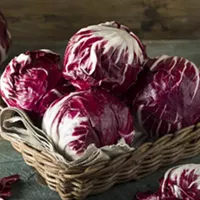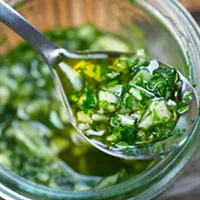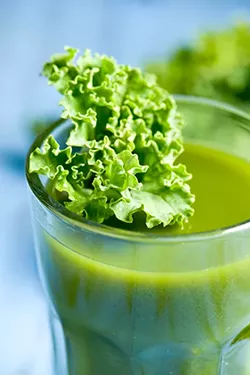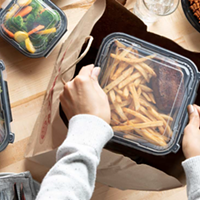The easiest way to consume loads of fiber is to drink it. Whether it's a powdered supplement stirred into a glass of water, or a delicious green smoothie, drinking fiber is a stealthy way to get it down, compared to chomping your way through a pile of whole grains, stems and leaves. While it is possible to overdo it on fiber, those who enjoy rich, high-fat meals could almost always benefit from a bit more.
Fiber is a catch-all phrase for carbohydrates, such as cellulose, that we cannot digest. Although we can't derive energy or nutrients from these particles, they exert their goodness in other ways, such as feeding the microbes in our gut, scrubbing your pipes like an intestinal Brillo pad, and helping to regulate blood sugar and fat.
Fiber does what it does, regardless of how long the actual, literal strands of fiber are. And when chopped small enough, you may not even realize you're eating fiber. With some supplements, like psyllium husk, you are eating the plant equivalents of random animal parts you eat in hot dogs.
The beauty of a green smoothie is that you take your fibers easily and deliciously, in the form of fresh fruits and veggies. The wintertime analog to this dish is pureed soup. I call it Winter Purry, because when I'm sitting all winter cozy with my bowl of soup, I feel purry like a happy cat in a splash of light.
The same way a summer smoothie, cold and fruity, quenches the thirst of a hot day, a good winter purry offers a seasonal antidote that's similarly vitamin-rich, but warming.
There are endless ways to make a purry, but most recipes can be simplified to a few basic steps and ingredients.
You'll need some good stock or broth, either of meat, vegetable, mushroom... it really doesn't matter. I keep a jar of Better than Bouillon paste, which is an excellent substitute for homemade. But really, if a kitchen is halfway organized there's no reason to run out of homemade stock.
You will also need some sort of tool with which to puree your purry. I use the immersion blender. I call it The Tool.
Finally, you need your fiber-filled winter vegetables, prepared in a way that softens them for your tool. They can be roots like carrots; stems like celery; seeds such as lentils; fruits a la a tomato; florets from broccoli and the like, and various leaves.
The drill is simple. Sauté the onion in oil with spices. You don't even need to cut the onion super small, because it will be soft, and because we have our tools. Meanwhile, prepare your other veggies by steaming until soft-either separately in the steamer, or added to the steamer in proper order (roots and other hard things first, leaves and other soft parts last). When the onions are translucent, transfer the softened veggies to the pan of onions and allow to cook, along with some minced garlic. When it starts to brown deliciously, deglaze with several cups of stock and simmer with the lid on for 20 minutes or so. Allow it to cool to a point your tool can handle, and puree.
Alternatively, just cook your favorite veggie-based meal — say, a stir-fry — and then hit it with your tool. It will probably be great.
No vegetable epitomizes the green smoothie like kale, and there is a place for everyone's favorite leafy green roughage in the winter purry as well. But you have to be careful not to overdo it, as happened to me when I thought I could just substitute pureed kale for spinach and make a cheesy saag paneer. I practically overheated my poor tool on that kale, as I had neglected to remove the stems. The dish tasted OK, but as it cooled it hardened into something like kevlar-reinforced green concrete.
The trick, I've since learned, is to first make the kale into chips, and then crumble them into purry. On that note, here is a recipe for Kale and Cauliflower Purry, adapted (and renamed) from the Williams-Sonoma Vitamix sales literature. Since cauliflower is the new kale, according to Bloomberg, this seems like an appropriate combination, a blended blend of old and new it veggies. To boot, the greenhouse-grown kale that's in season right now in cold regions, and available at local winter markets ,is some of the tastiest you will find. The cold weather keeps the leaves sweet and tender.
Kale and Cauliflower Purry
- 1 head of cauliflower, deconstructed into florets, with the larger ones sliced in half
- Olive oil, salt, pepper, garlic powder
- 8 or so cups of stock or broth
- Bunch of kale, leaves stripped and torn into evenly-sized chunks, about 2-inches across
- 3 sticks celery
- 1 onion
- herbs and spices
Preheat oven to 400 degrees.
Toss the cauliflower in olive oil, salt, pepper and garlic powder. Place them in the oven on a baking sheet.
Toss the kale with the same oil and spices as the cauliflower, and spread them on a tray.
After the cauliflower has been in the oven for about 25 minutes, reduce heat to 300. Add the kale tray to the oven. Monitor the chips closely as they cook, and take them out before they get too crispy, as they will continue to crisp after you remove them. You want them bright green and shiny with oil. Remove the cauliflower when it's done.
In a heavy bottom pan, sauté the onion and celery. Add the garlic, and a few minutes later, the stock and cauliflower. Cook, covered, until everything is tool-tender. The kale chips can be added before it is pureed, or after, as a garnish. Or both. This purry can handle many different spices, from harissa to herbs de Provence; I take mine with a mix of toasted and crushed cumin and coriander seeds.
To serve, ladle into bowls, or a steaming cup, and sip your fiber pleasantly.
Speaking of...
Latest in Food & Drink Features
More by Ari LeVaux
-

No One Knows How to Cook Radicchio
Oct 10, 2018 -

Hurry, Hurry, Chimichurri
Sep 19, 2018 -

The Real Way to Ramen
Aug 29, 2018 - More »
Calendar
-

Queen City Tequila Festival @ Blush CLT
-

Queen City Mimosa Festival & Day Party @ Blush CLT
-

Tuesday Takeover: Yongwon Hwang - Tuesday, September 9 @ L'Ostrica
-

Celebrate AAPI Food, Culture, & More at Panda Fest Charlotte! @ Ballantyne’s Backyard
-

Armored Car Brewing Food Truck Friday @ Armored Cow Brewing
-
Recipe: Pineapple-Oxtail Marmalade Tarts
It's marmalade. With meat in it. In a cookie. This is a trust-me moment, readers.
-
Phat Burrito expand hours; Amelie's opens new shop
-
Recipe: Spice Cake with Vanilla Cream Cheese Frosting 2
Pessimism, greed, and vanilla frosting - It's all waiting for you inside.












